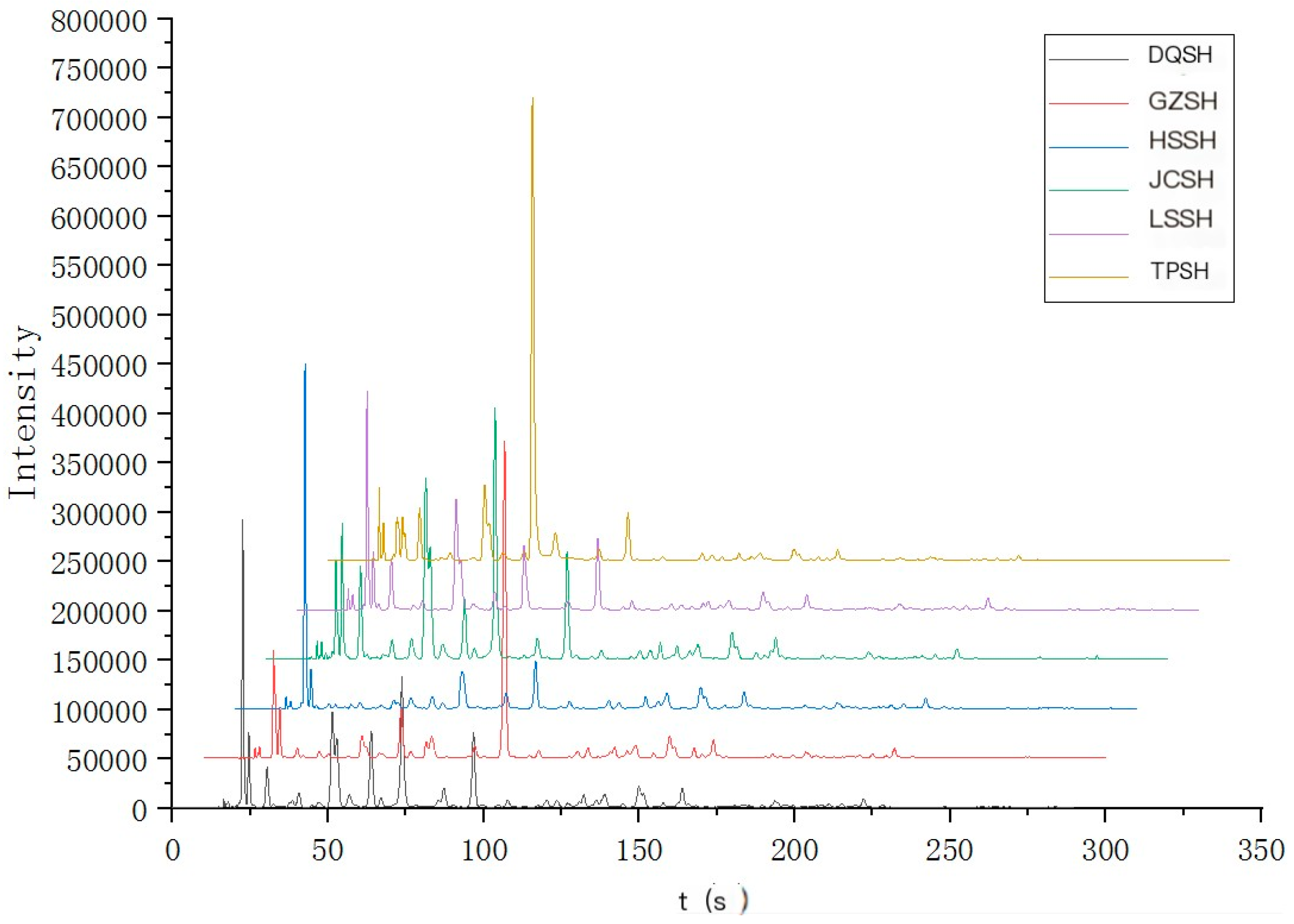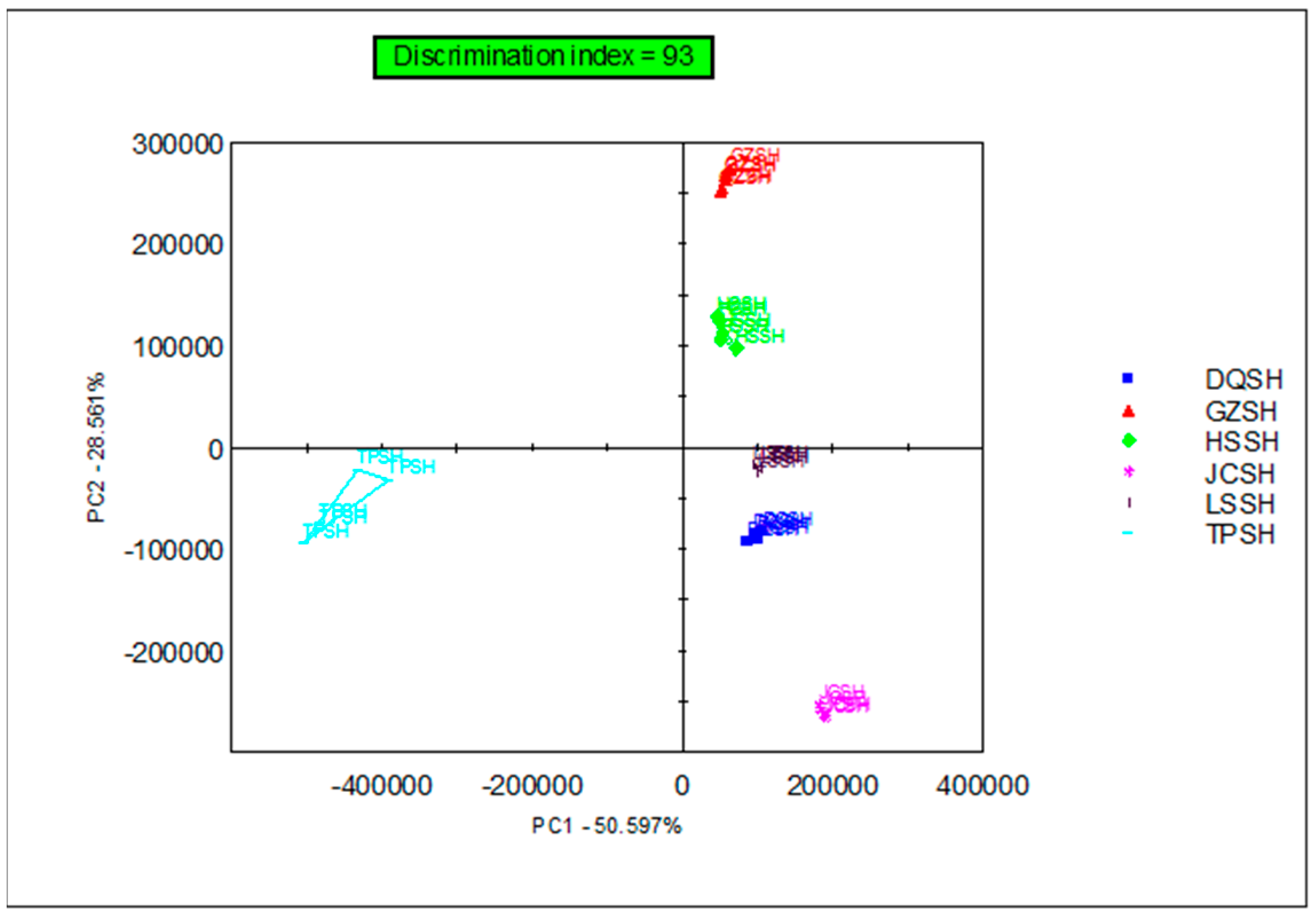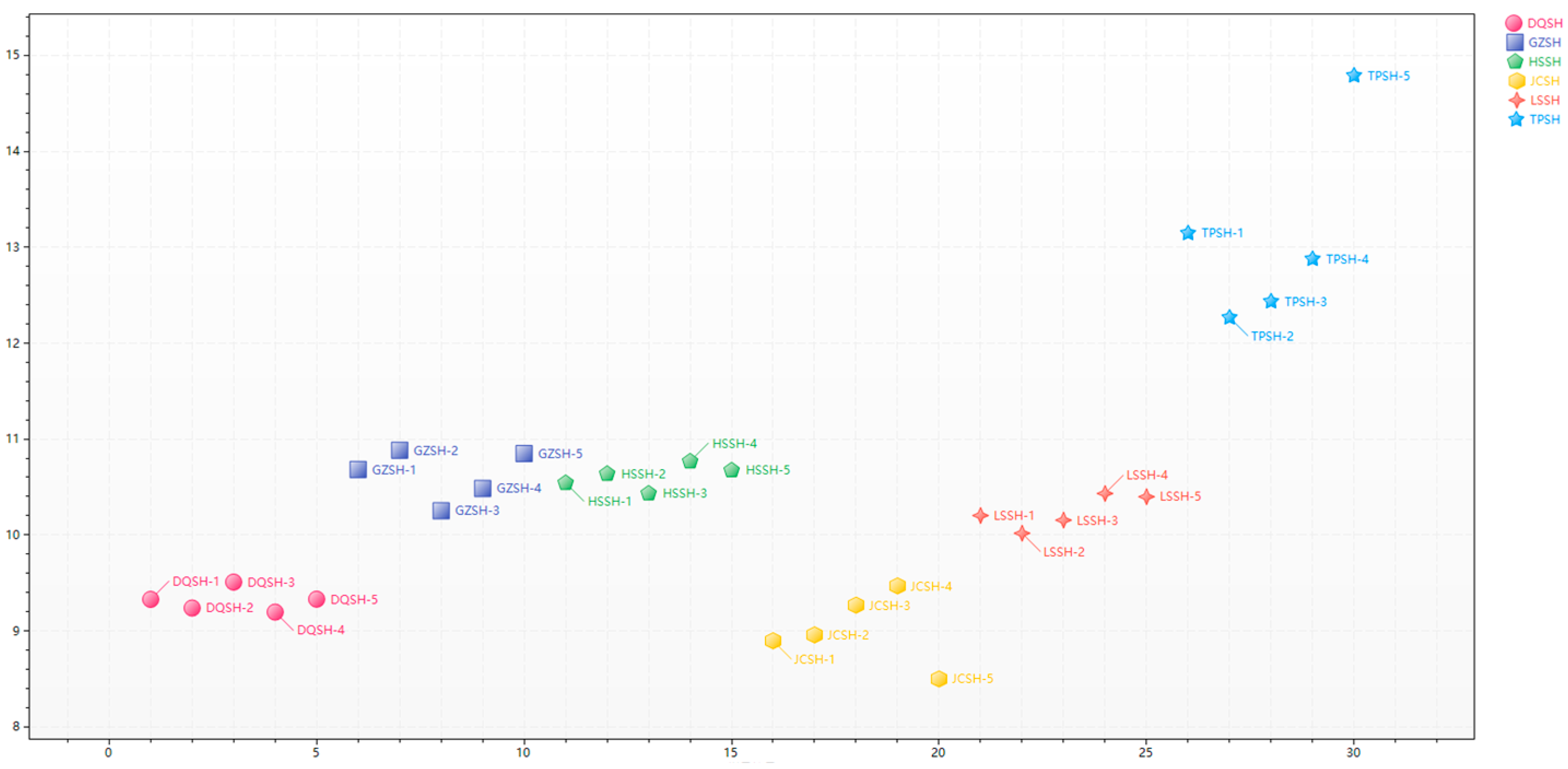Exploratory Study on Distinguishing Dendrobium Stem and Five Species of Dendrobium Using Heracles Neo Ultra-Fast Gas Phase Electronic Nose
Abstract
1. Introduction
2. Materials and Methods
2.1. Materials
2.1.1. Sample Preparation
2.1.2. Heracles Neo Ultra-Fast Gas Phase Electronic Nose Analysis Conditions
2.2. Statistical Analysis
3. Results
3.1. Heracles Neo Analysis
3.2. Principal Component Analysis (PCA)
3.3. Euclidean Distance Analysis
3.4. Compound Identification
4. Discussion
5. Conclusions
- The VOCs of Dendrobium stem and five types of Dendrobium samples were analyzed, and a total of 20 odor chemical components were identified. The gas chromatogram results obtained from the MXT-1701 and MXT-5 chromatographic column analysis were similar. It was observed that there are certain differences in the retention time and peak area of the six Dendrobium stem and Dendrobium samples.
- PCA also verified that there are obvious odor differences between Dendrobium stem and its related Dendrobium species.
- According to the Euclidean distance, the difference between the Dendrobium stem sample and the JCSH sample was the largest.
- The AroChemBase database was used to characterize the screened chromatographic peaks with large differences, and two unique compounds in the Dendrobium stem sample were found: 3-methylbutanal and n-butanol.
Author Contributions
Funding
Data Availability Statement
Acknowledgments
Conflicts of Interest
References
- Zhang, P.; Zhang, X.; Zhu, X.; Hua, Y. Chemical Constituents, Bioactivities, and Pharmacological Mechanisms of Dendrobium officinale: A Review of the Past Decade. Agric. Food Chem. 2023, 41, 14870–14889. [Google Scholar] [CrossRef] [PubMed]
- Cha, S.Y.; Park, S.Y.; Lee, J.S.; Lee, K.H.; Kim, J.H.; Fang, Y.; Shin, S.S. Efficacy of Dendrobium candidum polysaccharide extract as a moisturizer. Cosmet. Dermatol. 2022, 7, 3117–3126. [Google Scholar] [CrossRef] [PubMed]
- Chinese Pharmacopoeia Commission. Pharmacopoeia of the People’s Republic of China; China Medical Science and Technology Press: Beijing, China, 2020; Volume I, p. 295. [Google Scholar]
- Wu, W.; Zhao, Z.; Zhao, Z.; Zhang, D.; Zhang, Q.; Zhang, J.; Fang, Z.; Bai, Y.; Guo, X. Structure, Health Benefits, Mechanisms, and Gut Microbiota of Dendrobium officinale Polysaccharides: A Review. Nutrients 2023, 23, 4901. [Google Scholar] [CrossRef] [PubMed]
- Bhardwaj, K.; Bhargav, R.; Patocka, J.; Sharma, R.; Navratilova, Z.; Oleksak, P.; Kuca, K. Dendrobine: A neuroprotective Sesquiterpenic Alkaloid for the Prevention and Treatment of Diseases: A Review. Mini Rev. Med. Chem. 2024, 24, 1395–1408. [Google Scholar] [CrossRef] [PubMed]
- Kirkwood, A.; Fisk, I.; Ayed, C.; Xu, Y.; Yang, N. A flavour perspective of Tiepishihu (Dendrobium officinale)—An emerging food ingredient from popular traditional Chinese medicinal plants: A review. Int. J. Food Sci. Technol. 2023, 10, 4921–4930. [Google Scholar] [CrossRef] [PubMed]
- Wang, Z.; Zhao, M.; Zhang, X.; Deng, X.; Li, J.; Wang, M. Genome-wide identification and characterization of active ingredients related β-Glucosidases in Dendrobium catenatum. BMC Genom. 2022, 1, 612. [Google Scholar] [CrossRef] [PubMed]
- Wang, Q.T.; Wang, C.F.; Liu, Y.; Zhan, R. Bibenzyl-Phenylpropane Hybrids with Immunosuppressive Activities from Dendrobium Nobile Lindl. Chem. Biodivers. 2024, 21, e202400283. [Google Scholar] [CrossRef] [PubMed]
- Zeng, B.; Yan, Y.; Zhang, Y.; Wang, C.; Huang, W.; Zhong, X.; Chen, Z.; Xie, M.; Yang, Z. Dendrobium officinale Polysaccharide (DOP) inhibits cell hyperproliferation, inflammation and oxidative stress to improve keratinocyte psoriasis-like state. Adv. Med. Sci. 2024, 1, 167–175. [Google Scholar] [CrossRef] [PubMed]
- Zou, J.; Song, Q.; Shaw, P.C.; Zuo, Z. Dendrobium officinale regulate lipid metabolism in diabetic mouse liver via PPAR-RXR signaling pathway: Evidence from an integrated multi-omics analysis. Biomed. Pharmacother. 2024, 173, 116395. [Google Scholar] [CrossRef]
- Luo, D.; Qu, C.; Zhang, Z.; Xie, J.; Xu, L.; Yang, H.; Li, C.; Lin, G.; Wang, H.; Su, Z. Granularity and Laxative Effect of Ultrafine Powder of Dendrobium officinale. Med. Food 2017, 2, 180–188. [Google Scholar] [CrossRef] [PubMed]
- Bao, Y.H. Identification and Evaluation of Germplasm Resources of Dendrobium Officinale. Ph.D. Thesis, Guangzhou University of Chinese Medicine, Guangzhou, China, 2015. [Google Scholar]
- Chen, Q.Y.; Huang, Y.T.; Xu, G.H.; Wu, A.Z.; Wei, X.B.; Guo, H. Research progress on active ingredients and identification technology of Dendrobium officinalis. Stud. Trace Elem. Health 2022, 6, 65–67. [Google Scholar]
- Yang, Y.; She, X.; Cao, X.; Yang, L.; Huang, J.; Zhang, X.; Su, L.; Wu, M.; Tong, H.; Ji, X. Comprehensive evaluation of Dendrobium officinale from different geographical origins using near-infrared spectroscopy and chemometrics. Spectrochim. Acta A Mol. Biomol. Spectrosc. 2022, 277, 121249. [Google Scholar] [CrossRef] [PubMed]
- Liu, J.; He, T.; Chun, Z. DNA molecular identification of Herba Dendrobii and its adulterant species based on ITS sequence analysis. China J. Chin. Mater. Med. 2009, 22, 2853–2856. [Google Scholar] [CrossRef]
- Asahina, H.; Shinozaki, J.; Masuda, K.; Morimitsu, Y.; Satake, M. Identification of medicinal Dendrobium species by phylogenetic analyses using matK and rbcL sequences. Nat. Med. 2010, 2, 133–138. [Google Scholar] [CrossRef] [PubMed]
- Zhang, Y.H.; Li, T.F.; Wei, Z.J.; Qi, L.J.; Gao, W. Construction and application of a fingerprint library of pepper and pepper extract from different origins by ultra-fast gas chromatography electronic nose. China Food Addit. 2021, 9, 97–104. [Google Scholar] [CrossRef]
- Yu, Y.T.; Zhao, Y.M.; Yuan, X.; Chao, L.J.; Li, X.W.; Lu, T.L.; Yan, G.J. Quality evaluation of Astragali Radix from different origins, growth years and harvesting periods by Heracles Neo ultra-fast gas phase electronic nose. Chin. Tradit. Herb. Drugs 2022, 5, 1328–1337. [Google Scholar]
- Sipos, L.; Végh, R.; Bodor, Z.; Zaukuu, J.Z.; Hitka, G.; Bázár, G.; Kovacs, Z. Classification of Bee Pollen and Prediction of Sensory and Colorimetric Attributes-A Sensometric Fusion Approach by e-Nose, e-Tongue and NIR. Sensors 2020, 23, 6768. [Google Scholar] [CrossRef] [PubMed]
- Zhao, Q.L.; Jiang, Q.Y.; Yan, H.; Zhai, C.; Guo, S.; Pan, H. Rapid Identification and Odor Differential Markers of Distinct Origin-Derived Lycium barbarum L. Based on Ultra-Fast Gas Phase Electronic Nose. J. Nanjing Univ. Tradit. Chin. Med. 2023, 6, 513–522. [Google Scholar] [CrossRef]
- Li, M.X.; Qin, Y.W.; Li, Y.; Zhang, J.B.; Ji, D.; Qu, L.Y. Rapid identification and differential markers of Curcumae Radix decoction pieces of different sources based on Heracles Neo ultra-fast gas phase electronic nose. China J. Chin. Mater. Med. 2023, 6, 1518–1525. [Google Scholar] [CrossRef]
- Abdelhafez, O.H.; Othman, E.M.; Fahim, J.R.; Desoukey, S.Y.; Pimentel-Elardo, S.M.; Nodwell, J.R.; Schirmeister, T.; Tawfike, A.; Abdelmohsen, U.R. Metabolomics analysis and biological investigation of three Malvaceae plants. Phytochem. Anal. 2020, 2, 204–214. [Google Scholar] [CrossRef]
- Gupcsó, K.; Kókai, Z.; Bálint, M.; Tavaszi-Sárosi, S.; Németh, É.Z. Studies on Sensory and Phytochemical Characteristics of Poppy (Papaver somniferum L.) Varieties for Their Oil Utilisation. Foods 2023, 17, 3165. [Google Scholar] [CrossRef] [PubMed]
- Rao, D.; Zheng, S.G.; Zhao, T.M.; Yan, S.; Hu, Y.D.; Zhao, R.X. Correlation analysis and breeding application of agronomic traits and quality indexes in Dendrobium nobile. China J. Chin. Mater. Med. 2021, 13, 3330–3336. [Google Scholar] [CrossRef]
- Zhao, Y.W.; Jia, W.M.; Wang, Z.J.; Liang, L.D. Synthesis of 2, 3-pentanedione. Chem. Reag. 2012, 5, 479–480. [Google Scholar] [CrossRef]
- Zhang, Q.; Tang, J.; Deng, J.; Cai, Z.; Jiang, X.; Zhu, C. Effect of Capsaicin Stress on Aroma-Producing Properties of Lactobacillus plantarum CL-01 Based on E-Nose and GC-IMS. Molecules 2023, 1, 107. [Google Scholar] [CrossRef] [PubMed]
- Jing, W.; Zhao, X.; Li, M.; Hu, X.; Cheng, X.; Ma, S.; Wei, F. Application of Multiple-Source Data Fusion for the Discrimination of Two Botanical Origins of Magnolia Officinalis Cortex Based on E-Nose Measurements, E-Tongue Measurements, and Chemical Analysis. Molecule 2022, 12, 3892. [Google Scholar] [CrossRef] [PubMed]
- Ding, Y.; Dai, Y.D.; Ding, M.; Chen, P.; Wang, Q. The flavor differences of different substrates were analyzed by electronic nose, electronic tongue and HS-SPME-GC-MS. J. Fungal Res. 2024, 536. [Google Scholar] [CrossRef]
- Lu, S.; Han, B.; Yu, B.; Hong, M.; Chen, J.; Chen, J. Comparative Analysis of Morphological and Microscopic Characteristics of Dendrobium officinale from 3 Different Producing Areas. J. Shaoguan Univ. Nat. Sci. 2023, 6, 46–51. [Google Scholar] [CrossRef]
- Huang, X.; Zhong, K.; Han, K.; Yang, T.; Liu, X. Traits and microscopic characteristics of Dendrobium nobile from different habitats. Chin. Tradit. Herb. Drugs 2020, 8, 2226–2231. [Google Scholar] [CrossRef]






| No | Samples | Reference Samples | Distances |
|---|---|---|---|
| 1 | DQSH | LSSH | 156,238.38 |
| 2 | HSSH | LSSH | 218,794.38 |
| 3 | DQSH | HSSH | 258,579.73 |
| 4 | DQSH | JCSH | 274,603.97 |
| 5 | JCSH | LSSH | 347,958.44 |
| 6 | GZSH | HSSH | 383,406.91 |
| 7 | GZSH | LSSH | 390,504.59 |
| 8 | DQSH | GZSH | 415,967.47 |
| 9 | HSSH | JCSH | 507,226.97 |
| 10 | GZSH | JCSH | 542,578.25 |
| 11 | DQSH | TPSH | 503,096.31 |
| 12 | LSSH | TPSH | 575,097.00 |
| 13 | HSSH | TPSH | 576,347.06 |
| 14 | GZSH | TPSH | 626,721.75 |
| 15 | JCSH | TPSH | 685,332.94 |
| No | Compounds | CAS | RI (RT-5) | RI (RT-1701) | Odor Description | Odor Threshold |
|---|---|---|---|---|---|---|
| 1 | Ethanol | 64-17-5 | 419 | 583 | Alcoholic; Ethanol; Etheral; Fragrant; Pleasant; Pungent; Strong; Sweet; Weak | 1.54 × 102 (air) |
| 2 | Propenal | 107-02-8 | 451 | 607 | Acrid; Almond; Cherry; Choking; Hot fat; Pungent; Sharp; Sweet | 0.17 (air) |
| 3 | Acetonitrile | 75-05-8 | 543 | 644 | Aromatic; Etheral; Sweet | 1.76 × 102 (air) |
| 4 | 1-Butanamine | 109-73-9 | 619 | 705 | Ammoniacal; Fishy | 0.36 (air) |
| 5 | 3-methylbutanal | 590-86-3 | 654 | 741 | Aldehydic; Almond; Apple; Cheese; Chocolate; Fatty; Fruity; Green; Herbaceous; Malty; Peach; Toasted | 2 × 10−3 (air) |
| 6 | But-(E)-2-enal | 123-73-9 | 658 | 745 | Floral; Green; Plastic; Pungent | 0.42 (air) |
| 7 | N-butanol | 71-36-3 | 664 | 799 | Alcoholic; Amyl alcohol; Banana; Cheese; Fermented; Fruity; Fusel; Harsh; Medicinal; Oil; Rancid; Strong; Sweet | 1.12 (air) |
| 8 | Trometamol | 77-86-1 | 668 | 750 | Characteristic | - |
| 9 | 2,3-Pentanedione | 600-14-6 | 703 | 792 | Almond; Apple; Burnt; Butter; Butterscotch; Caramelized; Cheese; Creamy; Diacetyl; Fresh; Fruity; Grain; Malty; Nutty; Oily; Pungent; Sickly; Sweet | 0.02 (air) |
| 10 | 3-Methylbut-2-en-1-ol | 556-82-1 | 765 | 864 | Fruity; Green; Herbaceous; Lavender | 0.25 (water) |
| 11 | Hexanal | 66-25-1 | 804 | 894 | Acorn; Aldehydic; Fatty; Fishy; Fresh; Fruity; Grassy; Green; Herbaceous; Leafy; Sharp; Strong; Sweaty; Tallowy; Vinous | 0.04 (air) |
| 12 | 2,4-Octadiene | 13643-08-8 | 823 | 821 | Glue; Warm | 1.2 × 10 (oil) |
| 13 | M-Xylene | 108-38-3 | 873 | 927 | Aromatic; Cold meat fat; Plastic; Sweet | 0.60(air) |
| 14 | 3-Ethyloctane | 5881-17-4 | 966 | 975 | - | - |
| 15 | beta-Pinene | 127-91-3 | 978 | 985 | Dry; Green; Hay; Musty; Pine; Resinous; Sweet; Turpentine; woody; Woody (dry) | 3.7 × 10 (air) |
| 16 | 1,3,5-trimethylbenzene | 108-67-8 | 994 | 997 | Aromatic; Herbaceous | 1.20 (air) |
| 17 | Decane | 124-18-5 | 1001 | 1001 | Alkane; Fruity; Fusel; Sweet | 1.13 × 10 (air) |
| 18 | ()-.-beta-.-Pinene | 18172-67-3 | 1015 | 1014 | Dry; Fresh; Green; Hay; Pine; Resinous; Terpenic; Turpentine; woody; Woody (dry) | 2.00 (air) |
| 19 | alpha-Phellandrene | 99-83-2 | 1024 | 1022 | Citrus; Green; Minty; Spicy; Terpenic; Turpentine; woody | 3.40 (air) |
| 20 | 1-Methyl-4-isopropenyl-1-cyclohexene | 138-86-3 | 1034 | 1040 | Citrus; Etheral; Fruity; Green; Lemon; Licorice; Orange; Pleasant | - |
| No | Compounds | CAS | Average Peak Area | |||||
|---|---|---|---|---|---|---|---|---|
| DQSH | GZSH | HSSH | JCSH | LSSH | TPSH | |||
| 1 | Ethanol | 64-17-5 | 119,106 | 44,504 | 138,883 | 42,433 | 90,168 | 17,394 |
| 2 | Propenal | 107-02-8 | 53,715 | 34,400 | 33,137 | 96,013 | 41,168 | 17,780 |
| 3 | Acetonitrile | 75-05-8 | 32,257 | 8706 | 8267 | 65,322 | 39,008 | 0 |
| 4 | 1-Butanamine | 109-73-9 | 7214 | 1690 | 1850 | 18,532 | 1580 | 5546 |
| 5 | 3-methylbutanal | 590-86-3 | 0 | 0 | 0 | 0 | 0 | 233,691 |
| 6 | But-(E)-2-enal | 123-73-9 | 80,160 | 20,714 | 8733 | 145,888 | 91,577 | 0 |
| 7 | N-butanol | 71-36-3 | 0 | 0 | 0 | 0 | 0 | 132,594 |
| 8 | Trometamol | 77-86-1 | 54,932 | 8724 | 6018 | 88,517 | 41,054 | 0 |
| 9 | 2,3-Pentanedione | 600-14-6 | 72,199 | 40,390 | 10,968 | 175,403 | 13,140 | 9402 |
| 10 | 3-Methylbut-2-en-1-ol | 556-82-1 | 12,463 | 4449 | 7717 | 14,522 | 4966 | 8173 |
| 11 | Hexanal | 66-25-1 | 59,134 | 245,694 | 47,192 | 80,454 | 54,779 | 37,616 |
| 12 | 2,4-Octadiene | 13643-08-8 | 35,463 | 20,428 | 23,021 | 42,265 | 17,095 | 26,329 |
| 13 | M-Xylene | 108-38-3 | 5615 | 6488 | 9261 | 6811 | 6800 | 2775 |
| 14 | 3-Ethyloctane | 5881-17-4 | 7257 | 5061 | 6011 | 7882 | 4031 | 4169 |
| 15 | beta-Pinene | 127-91-3 | 5813 | 5474 | 4551 | 5975 | 3236 | 3193 |
| 16 | 1,3,5-trimethylbenzene | 108-67-8 | 3625 | 4833 | 2307 | 1766 | 1706 | 1182 |
| 17 | Decane | 124-18-5 | 10,429 | 9200 | 12,370 | 10,371 | 6386 | 5608 |
| 18 | ()-.-beta-.-Pinene | 18172-67-3 | 6399 | 6363 | 5990 | 6897 | 4208 | 3856 |
| 19 | alpha-Phellandrene | 99-83-2 | 15,034 | 14,971 | 14,487 | 16,150 | 10,487 | 9003 |
| 20 | 1-Methyl-4-isopropenyl-1-cyclohexene | 138-86-3 | 4291 | 5194 | 2176 | 2179 | 1755 | 350 |
Disclaimer/Publisher’s Note: The statements, opinions and data contained in all publications are solely those of the individual author(s) and contributor(s) and not of MDPI and/or the editor(s). MDPI and/or the editor(s) disclaim responsibility for any injury to people or property resulting from any ideas, methods, instructions or products referred to in the content. |
© 2024 by the authors. Licensee MDPI, Basel, Switzerland. This article is an open access article distributed under the terms and conditions of the Creative Commons Attribution (CC BY) license (https://creativecommons.org/licenses/by/4.0/).
Share and Cite
Dai, Y.; Huang, D.; He, Y.; Xiang, Y.; Li, S. Exploratory Study on Distinguishing Dendrobium Stem and Five Species of Dendrobium Using Heracles Neo Ultra-Fast Gas Phase Electronic Nose. Separations 2024, 11, 211. https://doi.org/10.3390/separations11070211
Dai Y, Huang D, He Y, Xiang Y, Li S. Exploratory Study on Distinguishing Dendrobium Stem and Five Species of Dendrobium Using Heracles Neo Ultra-Fast Gas Phase Electronic Nose. Separations. 2024; 11(7):211. https://doi.org/10.3390/separations11070211
Chicago/Turabian StyleDai, Yuping, Dan Huang, Ye He, Yun Xiang, and Shunxiang Li. 2024. "Exploratory Study on Distinguishing Dendrobium Stem and Five Species of Dendrobium Using Heracles Neo Ultra-Fast Gas Phase Electronic Nose" Separations 11, no. 7: 211. https://doi.org/10.3390/separations11070211
APA StyleDai, Y., Huang, D., He, Y., Xiang, Y., & Li, S. (2024). Exploratory Study on Distinguishing Dendrobium Stem and Five Species of Dendrobium Using Heracles Neo Ultra-Fast Gas Phase Electronic Nose. Separations, 11(7), 211. https://doi.org/10.3390/separations11070211






